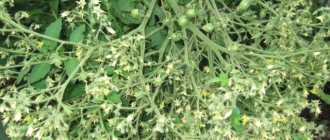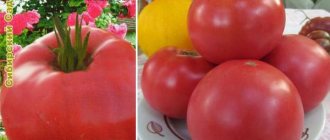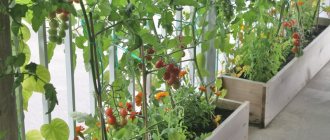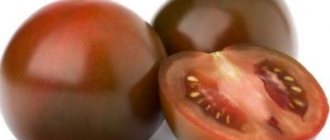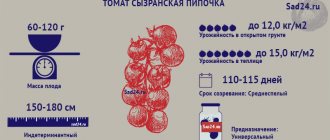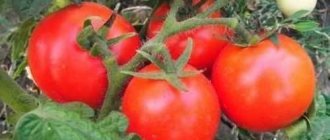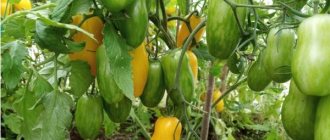Not only people are brave, but also tomatoes, which are distinguished by their high tolerance to cold and disease. The Brave General tomato is valued for its resistance to pathogens and the ability to grow both in greenhouses and in open beds.
| Height | Landing location | Ripening time | Fruit color | Fruit size | Origin | Fruit shape |
| Medium height | Greenhouse, Open ground | Early ripening | Pink | Large | Variety | Flat-round |
Varietal features
The homeland of the variety is Japan. In Russia, it was first grown in Altai.
Thanks to its positive characteristics, the plant soon spread throughout the entire territory of the state, then it began to be grown even in regions with harsh climatic conditions (in Siberia).
The gallant general is early ripening. The harvest ripens already 100-110 days after sowing the seeds in the soil. Fruit harvesting begins in mid-July. Greenhouse tomatoes can be harvested in the first half of July.
Description of fruits and bush
The bush is low-growing (does not exceed 75 cm in height). The shoots are spreading, the stem is strong. Up to 8 fruits are formed in one brush.
Fruit characteristics:
- shape – round, slightly pointed;
- structure – dense, glossy;
- skin – bright pink or red;
- the pulp is homogeneous, bright pink, dense, with the presence of a small amount of seeds;
- average fruit weight – 300 g;
- the taste is sweet and sour.
The variety bears fruit in a friendly manner - about 5-10 fruits ripen on the bushes at the same time.
Productivity
The variety is characterized by high productivity. With proper care, up to 400 kg can be harvested from 1 hectare per season.
():
On one hectare, with a tomato planting pattern of 50 x 70 cm, more than 28 thousand plants are placed. Even with a yield of 1 kg per bush, from 1 hectare you can get 28,000 kg or 28 tons of tomato fruits. This is the minimum harvest. But in reality, farmers receive 100-150 tons per hectare.
Purpose of fruits
Tomatoes The brave general of universal use. From fresh fruits you can prepare salads, cold appetizers, add them as a stir-fry to soups, and mix with other vegetables to make a vegetable stew.
The variety is also suitable for canning. It produces aromatic lecho, tomato paste, adjika, and juice.
It is allowed to include tomatoes in the children's menu. For young children, it is recommended to add them to soups or vegetable purees. Older children can eat them fresh and in salad form. Before adding a variety to the diet, it is important to make sure that the child is not allergic to the product.
Due to its excellent external characteristics, the variety is grown for sale.
Tomato Black Pear: description of the variety
Black pear is an indeterminate mid-season varietal tomato. The bushes are powerful and tall - usually reaching 1.3–1.7 m in open ground and about 2 m in a greenhouse. They require garters to the support and shaping.
The first fruits ripen in early July, 110–125 days after emergence. The tomatoes are slightly ribbed, pear-shaped, and acquire a burgundy-brown color when ripe. The average fruit weight is 60–80 g (the weight of the first ones can reach 100 g). The variety is characterized by long fruiting. The fruits have a universal purpose: they are used for preparing fresh salads, look original in a jar, and are ideal for processing into juice.
The average weight of black pear tomato fruit is from 50 to 80 g
Advantages and disadvantages of the variety
The Brave General variety is in demand among gardeners. Tomatoes are distinguished by their unpretentiousness and high yield.
The whole list of positive qualities:
- resistance to sudden weather changes;
- friendly (simultaneous) ripening of fruits, which facilitates the harvesting process;
- the ability to maintain the external quality of fruits during transportation and long-term storage;
- due to its dense structure, the skin of the fruit does not crack;
- excellent taste - sweet pulp, sugar content per 100 g of product - 4.5%;
- increased resistance to many diseases (powdery mildew, fusarium, etc.).
The variety is resistant to diseases
The fruits have a strong skin that does not crack during transportation and long-term storage. Another important advantage is that they are able to withstand long-term transportation without compromising their external qualities.
But like other plants, this variety also has disadvantages in the description, among which are:
- sensitivity to late blight (regular spraying with fungicides is carried out to prevent the development of the disease);
- impossibility of using seeds a second time (the tomato belongs to the group of hybrid varieties (F1), their distinctive feature is the impossibility of maintaining characteristics in subsequent generations.
Brave General - variety of Tomato plant
Information on admission of Tomato Braviy General from the Register of the State Variety Commission of the Russian Federation
Application for admission No. 46075, registered 2006-11-28. The Bravoy General Tomato variety was included in the register of those approved in 2008. Approved for use in regions: All regions.
The originator of the Bravy General Tomato variety is:
Information about the patent for the Bravy General Tomato variety
Patent holder of the Bravy General variety:
LLC AGROFIRMA SEEDS OF ALTAY (656015, BARNAUL, PROFINTERNA STREET, 9)
Application for protection of the Bravy General variety No. 46076, registered 2006-11-28.
Patent No. 4400, registered 2008-12-18. Estimated patent expiration date 2038-12-31.
Authors of the Tomato variety Bravy General
- Kotelnikova Marina Aleksandrovna
- Antipova Nadezhda Petrovna
Other varieties of tomato plant
Question to the portal experts
If you haven't found the answer to a question, don't hesitate to ask an expert.
Have you already planted the Brave General Tomato?
Tell us if you liked this variety? Will you plant it again?
Register or Login so you don't have to enter your Name and Email every time
Thanks for the comment! It will be published after checking by a moderator!
No comments yet, be the first!
A portal for those who love their dacha
Your question has been sent for moderation. Don't worry, we quickly check your questions and your question will be answered within 1 day.
We have noticed that you are already registered on our website. We recommend that you log in to view the created question.
If you don't remember your password, you can recover it.
You were not registered until today, so we have registered you. Your password has been sent to your specified mailbox.
Help our site develop!
Please read this message, it will not take up much of your time!
We so need your comments and questions to understand in which direction we should develop.
Don't forget to leave a comment if you found what you were looking for. And if you haven’t found it, use the “Ask an Expert” form in the site header. We will answer this question, and other visitors will be able to find the information that you could not find.
Your question has been sent for moderation. Don't worry, we quickly check your questions and your question will be answered within 1 day.
We have noticed that you are already registered on our website. We recommend that you log in to view the created question.
If you don't remember your password, you can recover it.
You were not registered until today, so we have registered you. Your password has been sent to your specified mailbox.
Growing seedlings
The seedling method of cultivation ensures early harvesting, which protects against late blight (disease activity occurs at the end of July - beginning of August).
The recommended time for sowing seeds for seedlings is the end of March (in regions with harsh climatic conditions - the end of March).
By the time of planting in open ground, the seedlings will have grown and become stronger, this will eliminate the risk of death of young plants under the influence of natural factors.
Soil preparation
An important point in sowing seedlings is the choice of soil. In specialized stores you can purchase a special soil composition marked “For tomatoes”. It is enriched with all the nutritional and mineral components necessary for plants, which will ensure active growth and full development.
If it is not possible to purchase special soil, then you can take ordinary soil from the garden to sow seedlings.
Good predecessors are pumpkin, zucchini, carrots and cabbage, so it is recommended to collect soil from the beds where the listed vegetables grew.
Before sowing, the soil is disinfected (soil purchased in a store does not need additional treatment).
Treatment is carried out by watering with a weak solution of potassium permanganate or thermally (heat in the oven). After this, you can apply organic fertilizer based on humate.
Selection of capacity
To sow seedlings, you can take any container - balcony boxes, small pots, peat cups, special seedling containers.
If the containers have already been used for growing seedlings, then before adding soil and seeds they need to be scalded with boiling water or washed with warm water using baking soda.
As soon as the preparatory activities are completed, soil must be poured into the selected containers and the seeds must be sown. Place containers with seeds in a warm room and water the soil. Additionally, immediately after sowing, wrap the containers with plastic wrap to create comfortable warmth. After 5-7 days, as soon as young shoots appear, the polyethylene must be removed.
Picking
Young seedlings develop very quickly. At the stage of appearance of 2 true leaves, it is necessary to make a pick: place the plants in separate containers.
Plastic cups (volume of at least 200 ml) or peat pots are suitable. They need to be filled with soil, carefully transplanted young seedlings, sprinkled with a small layer of soil, and watered with warm water.
Plants transplanted into separate pots are placed on the sunny side of the apartment - preferably on the windowsill.
Care
Tomatoes need to be fertilized regularly
Plants need to be watered as needed. Watering should be moderate and not frequent. It is recommended to regularly loosen the soil in pots; this will provide oxygen access to the soil, which will help the seedlings to develop more actively.
For nutrition, it is recommended to apply mineral or organic fertilizers to the soil weekly.
():
The first feeding of seedlings is carried out 7-10 days after picking, when the plants have taken root after transplantation.
Tomato Brave General: description of the variety
The Brave General tomato is highly resistant to various diseases. It is valued for its excellent taste. The plant can be grown outdoors in various regions of Russia. The variety was developed by Altai breeders. Tomatoes of this type are used for making salads and canning.
Brief information about the plant
The characteristics and description of the Brave General variety are as follows:
- These tomatoes ripen relatively early.
- The height of the plant bush can vary from 90 to 100 cm. The stem is covered with leaves by 40-45%.
- Simple inflorescences develop on the stem, the first of which appears above the 7th or 8th leaf.
- The inflorescences may produce 1-3 fruits, similar to a slightly flattened spheroid with small ribs. Inside a tomato there are 6 and sometimes more chambers with seeds.
- During the growth process, the fruits of the described variety turn pink, and during the ripening period they are crimson in color.
- The average weight of the fruit is 240-260 g, but reviews of farmers who planted this tomato variety show that many gardeners managed to grow fruits weighing 400-600 g, and the most successful gardeners grew fruits weighing up to 1 kg.
Characteristics with photos of the Brave General variety can be studied in various agricultural catalogs. The seeds of this tomato are best purchased from specialized seed farms, although some farmers obtain them themselves.
In the regions of the Far North and Siberia, Brave General tomatoes are best grown in greenhouses, as they do not tolerate sudden temperature changes characteristic of a continental climate. In central Russia, this variety grows well both in open ground and in unheated greenhouses.
Some farmers who planted this variety in open ground point out the need to tie the bushes to a strong support, since the stems may not support the weight of the growing fruits. This operation is carried out at the moment when the length of the stepsons reaches 20-25 mm. The variety produces high yields, but, according to breeders, Brave General has the potential for further development and increased yields.
Growing seedlings and large fruits
Gardeners often complain that tomato seedlings become very elongated, and the plants begin to shade each other, so the shoots are pale in color.
To curb the growth of seedlings, it is recommended to lower the room temperature to +16 °C. The plants need to be kept in this mode for a week. But they need to be well illuminated with a special lamp in March. Most often, 90-120 minutes of additional light are enough for sprouts.
While the seedlings are developing, they need to be fed with mineral and humic fertilizers. During the period of seedling growth, this operation is performed up to 4 times. If a gardener notices that the seedlings are growing higher and higher every year, then it is necessary to shift their sowing to a later date. Low seedlings tolerate stress better after planting in open ground.
Sufficient watering must be provided. For this variety, each bush requires up to 20 liters of water. Plants must receive the required amount of mineral and other fertilizers, which are applied to the soil in a volume of up to 40 g/m². In autumn, mineral fertilizers are replaced with manure in an amount of 3-4 kg/m². The frequency of feeding plants is once every 2 weeks. You can alternate mineral and liquid fertilizers; this does not affect the growth of tomatoes.
When growing the Bravy General variety in the southern regions of Russia, one must take into account the fact that at an air temperature of +26...+27 °C and above, pollination of the plant’s flowers will stop. The first ovaries that appear under such conditions do not bear fruit. To eliminate this negative phenomenon, it is recommended to shade the plantings with an awning.
When garden pests appear, it is recommended to spray tomato bushes with preparations that destroy various insects.
Planting seedlings in the ground
The procedure is carried out when the earth warms up to 16°. If this condition is not observed, then there is a risk of plant death due to freezing of the roots.
Seedlings can be planted in the ground when 6-7 permanent leaves have appeared on the bush and at least 1 cluster with ovaries has formed.
When planting plants in open ground, preparatory measures are required. 1-2 weeks before the planned planting, the soil is dug up, loosened and fertilized with minerals or compost.
Description of technology
- Tomato planting scheme - 4-5 bushes are placed per m².
- The distance between rows should be at least 40 cm.
- Dig holes, pour plenty of water into the soil, add a solution inside the holes - a root system growth stimulator (Epin, Kornevin).
- Place a layer of peat at the bottom of the hole.
- Carefully move the seedlings from the cup into the prepared hole.
- Sprinkle with soil.
- Water the plant.
():
Seedlings are sprayed with Epin one day before transplanting. This helps her quickly adapt to a new place and withstand possible unfavorable growth conditions.
All actions are carried out carefully. It is important to remember that the root system of seedlings is very sensitive; incorrect actions can injure it.
How to get tomato seedlings "General"
Like all early tomatoes for open ground, this variety is grown through seedlings in regions with temperate climates. In the southern regions it can be sown directly into the ground.
Sowing time for seedlings
Considering that the time for planting early tomatoes in open ground occurs in most regions only at the very end of May, they should be sown for seedlings between March 15 and March 20. Shoots will appear after a week, and by the time of transplantation the seedlings will have reached the desired age and size. In regions with late frosts, seedlings can be sown in the first week of April.
Sowing seedlings
If the seedlings are intended to grow tomatoes for sale, the seeds can be sown in boxes or seedling trays. For an amateur garden, you can use individual seedling cups with a capacity of 0.4 - 0.5 liters.
The selected containers are filled with earth. To do this, you can buy ready-made soil for crops from the Solanaceae family. You can make the mixture yourself, for this you need to take the following components:
- one part of garden land
- one part of humus
- a glass of wood ash per 10 kg of soil
After the seedling boxes or cups are filled with soil, water it well and plant the seeds at a depth of no more than 0.4 - 0.5 cm into the soil. The containers are covered with glass or film and placed in a warm room in a bright place. After germination, the glass is removed.
At the stage of three or four true leaves, the seedlings are plucked, and with the onset of warm weather they are transplanted into open ground. Before transplanting, the seedlings are hardened off 8-9 days before transplanting. To do this, in warm weather it is taken out into the open air for several minutes, gradually lengthening the period of stay in it to several hours. After watering the seedlings generously 48 hours before planting in the ground, they are no longer watered.
Video about sowing tomato seeds for seedlings:
Tomato care
Caring for growing tomatoes is easy. It includes several main stages.
- Watering. The root system goes 50 cm deep into the ground, and watering should ensure that moisture reaches the lower soil layers. On average, 5-6 liters are needed per bush. warm water.
- Weeding. As weeds appear, they need to be pulled out and destroyed. The accumulation of plant residues on the ridges should not be allowed.
- Loosening the soil promotes the active development of plants.
- Feeding. To be paid every 2 weeks. At the beginning of the formation of ovaries, tomatoes are fertilized with potassium compounds; in the future, fertilizing should contain nitrogen and phosphorus compounds.
():
The first feeding is carried out 7-10 days after planting the seedlings in the ground. It is carried out with nitrogen fertilizers, which are necessary for the growth of vegetative organs.
There is no need to shoot tomatoes of this variety, but it is recommended to regularly trim the lower leaves.
During the entire growing season, it is necessary to regularly “powder” the soil and the lower part of the plant with wood ash.
How to grow very large fruits
Fruit size is determined by a number of growth factors.
The main thing is to maintain all the following factors within optimal limits:
- Plant nutrition area. The optimal feeding area for the Brave General variety is 50 x 70 and 70 x 70 cm. With this planting scheme, the plants will be provided with sufficient air nutrition, well lit by the sun and receive a lot of heat;
- Watering the plants should be sufficient. The root system of indeterminate varieties goes 50-60 cm deep. Watering should ensure soil wetting to this depth, and average 15-20 liters of water per bush;
- Mineral nutrition of plants should be increased and compensated by a combination of all forms of fertilizers: organic, mineral, humin-based and amino acids. The main fertilizer is applied in the form of mineral fertilizers during planting, on average 30-40 g/m2. Manure - from autumn, average dose 4 kg/m2. Humic and amino acid fertilizing, every 10-14 days during the growth period, until the fruit begins to ripen. Fertilizing with organo-mineral fertilizers can be alternated with fertilizing with a liquid infusion of mullein or bird droppings;
- Temperature conditions during the period of growth and fruiting. Tomato plants are native to the forests of South America, where the weather is warm and humid most of the year. Therefore, the optimal temperature for tomato growth is 24-26 o C. At air temperatures above these values, pollination of tomato flowers stops, and the plants experience stress. This is often observed in the southern arid regions, when the first flowers produce an ovary, and with the onset of intense heat, fruit formation stops.
Disease and pest control
The variety is resistant to various types of diseases, but it is not protected from late blight. In order to prevent the development of a pathogenic process dangerous to plants, it is recommended to spray the crop with a 1% solution of Bordeaux mixture every 3 weeks until fruit formation.
If the tomatoes still begin to show signs of late blight, you should immediately begin treating the bush. Late blight therapy is carried out with fungicidal drugs - Healer, Quadris, Acrobat, Ridomil.
():
Chemicals can be used to combat fungal and bacterial diseases no later than 3 weeks before harvest.
Good variety of tomatoes Korolevich and Brave General
Write it down so you don't forget! Very Productive Tomatoes. Just a Miracle!
333. Liked the tomatoes from Semyon Altai
Tomatoes are not protected from pest attacks, but preventive measures will help reduce the risk of damage to a minimum. The most common pests of the variety are aphids and spider mites. Chemical and biological drugs are used against their activity.
- Against aphids - treatment of the lower part of tomato leaves and bushes with biological preparations Actofit, Metarizin.
- Against spider mites - timely destruction of affected leaves, treatment with biological products (Fitoverm).
Reviews about the variety
Tomatoes Brave General are an unpretentious, productive variety. As experienced summer residents say, the plant is resistant to disease and can withstand sudden climate changes.
Like any agricultural crop, the variety has both advantages and disadvantages. Among the negative aspects, gardeners highlight only the tendency to develop late blight, but if proper care is provided and timely prevention is organized, the dangerous disease is not terrible.
Caring for the crop is simple. The plant needs timely watering and comprehensive care (destruction of weeds, loosening the soil, fertilization, protection from pests).
How to fertilize correctly?
Remember that fertilizing is needed at least 3 times per season, but it should be moderate. Fertilizers serve as top dressing:
- Complex.
- Mineral.
- Organic.
Among the most popular fertilizers are:
- Bird droppings.
- Herbal infusions.
- Ashes, ash.
But remember that excessive fertilization can also harm the plant, so everything should be done in moderation. If you are a beginner vegetable grower, then you can use store-bought bait, where, according to the instructions, it will be quite easy to fertilize correctly.
READ MORE: Tomato Amur Zarya: characteristics and description of the variety with photos
